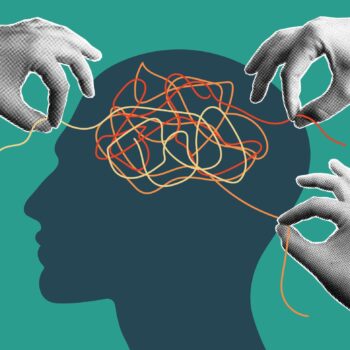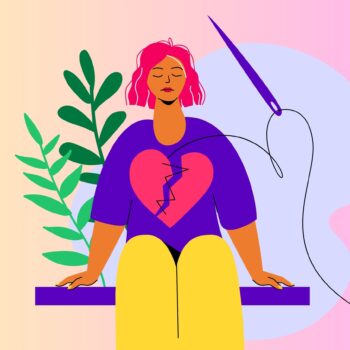Yoga for Grief: an introduction
/ General : Litsa
Today's guest author is Kiri Meyer. Kiri is a Licensed therapist in WI, specializing in grief and trauma. She’s also a Registered Yoga Teacher focused on teaching trauma-sensitive restorative yoga for grief. Most importantly, she’s been a grieving child, teen, young adult, and adult. She’s passionate about supporting those who are walking their own grief path and advocating for a more compassionate world for all of us to grieve in our own ways.
“You should try doing some yoga.” A sentence many grieving individuals may hear from a well-meaning acquaintance, as they try to help us feel “better”.
So if you have clicked on this article, even as you may be rolling your eyes, let me calm your fear right now - this is not an article on how yoga can “fix” your grief! It is, however, an article intended to explain the benefits that can be felt from incorporating physical movement, such as yoga, into your self-care routine.
I always like to know who is behind the information that I’m reading, so I just wanted to quickly introduce myself. Hi, I’m Kiri Meyer, MS, LPC, NCC, RYT-200. I am a Licensed Professional Counselor specializing in grief and trauma, as well as a Registered Yoga Teacher. I think it’s also important to note that I have been a grieving child, teenager, young adult, and now am a grieving adult. So, I’m not just here preaching, I’m also constantly practicing.
Should we get some of the science out of the way first?
The practice of yoga - a combination of mindful breathwork and physical poses (called asanas) can actually interrupt the activation of our sympathetic nervous system. The sympathetic nervous system is often known as our flight, fight, or freeze response that can be activated in times of stress and grief. With the help of yoga, we can engage our parasympathetic nervous system. The parasympathetic nervous system is the rest and digest response, which may sometimes feel elusive in moments of intense stress and grief. When we engage our parasympathetic nervous system, we are actually working on re-regulating our bodies - leading to to:
- Reduced stress, anxiety, depression, and chronic pain.
- Improved sleep patterns. 1
- Enhanced quality of life and overall well-being.1
As I work with clients, these are some of the largest issues individuals present as part of their grief journeys. So just these three things alone might pique your interest in beginning or continuing a yoga practice.
Another aspect of grief that isn’t often spoken about is lack of control. Grief may feel as though it just happened to us and now our whole lives have to change, shift, and rearrange because of it. This lack of control can be due to secondary losses - the losses that accompany the origin loss. These can include but are not limited to, loss of: financial security, residence, routine, relationship, safety, etc. We can also feel a loss of control from the waves of grief we experience. As much as we may try to control them, they sure can sneak up on us when we’re least expecting it!
With yoga, we are able to take a healthy feeling of control into our hands. We can choose the length of our practice, where we practice, what kind of yoga we practice, who we practice with, and we can make adjustments with our bodies in different poses to do what feels right. That’s a lot of feel-good choices right there!
Types of yoga
While we are mentioning types of yoga, let’s dive into that a bit more. These days, I’m pretty sure you can find whatever kind of yoga you can think of, offered in your community or virtually. Just like grief, our taste in yoga can be quite unique - even day-to-day. Some individuals speak about hot yoga as a way to challenge themselves and cleanse their bodies as they swat out their toxins. Others will swear by yin or restorative yoga as a way to keep moving their bodies but feel a great sense of compassion for their bodies in the midst of grief. If you look hard enough, there will be someone who swears by every kind of yoga we can imagine, but the real question is what feels right for you?
The best way to answer that question is to try out different kinds of yoga that look interesting and see what feels like a good fit!
I like the idea of making yoga accessible for everyone and every body. You don’t have to be a super-in-shape-headstand-master to feel the benefits from yoga, so here are a few tips to figuring out how to make yoga fit for you:
Altered breathing practices + guided meditations:
Many yoga classes may dive into altered breathing before, during, or after the practice. As a trauma-informed yoga teacher, I will encourage individuals that may have some trauma or grief triggers to opt out of these practices. While these are great for some, others share that it can engage feelings of anxiety and/or lightheadedness. This feeling of overwhelm may also happen when going through a guided meditation. Know that you can always come out of that space and back into the present by opening your eyes and gently finding movement in your body (wiggling your fingers and toes, stepping away from the space you were in, etc.)
Remember: YOU get to control what feels right for you, and you can opt out of this or any other practices that don’t feel right for you.
A question I get often is, “If I’m not going to do altered breathing, what kind of breathing should I do?” Just stick to your natural breath, or maybe even mindfully creating slower and deeper breath from your diaphragm, if that feels right for you. There is such power in focusing on our breath. Try it when you are in the midst of a grief wave. It can really help us to release pent up feelings or even things out so we can help the waves to pass.
Props:
It can look really expensive to do yoga. You might feel the pressure to have the “right” tools. Great news! There are so many alternative items you can use that will work just great. Don’t have a mat? I often do yoga on my carpet. All you need is a non-slip surface. Don’t have yoga blocks? Sturdy books or even cans of food can work well. Don’t have a yoga strap? A belt is a perfect substitute. Don’t have a yoga blanket? That’s totally fine - use whatever blanket you have in your home. Don’t have a bolster? Maybe you just grab a few pillows and create your own. Let’s not let the idea of “perfect yoga materials” stop us from getting the support we want.
Some yoga teachers may use wording such as, “Use a prop here if you need it.” I usually add “Or if it feels good.” It’s important to note that using a prop is not a bad thing! We may find that grief can make us feel a bit more stiff, weak, or tired. Using props can be a great way to feel extra support in our practice.
Yoga purpose:
Before doing or scheduling your yoga, take a moment to check in with yourself and ask, “What would I like the purpose of my yoga to be?” Sometimes our grief leaves us feeling aggravated and we need a physical outlet, which may lead us to a higher effort yoga or a longer practice. If grief feels like it’s taking everything out of you lately, you may turn towards a shorter practice or a more restorative vibe. Do you find mornings or before bed to be challenging for your grief? Possibly all you need are a few of your favorite gentle poses to help you get into a different frame of mind. Even if you are feeling your grief pop up at work or school, there’s chair yoga that can be added into your day.
Emotional releases during yoga can be common if we don’t have other outlets to express our grief. Maybe you just sit on your mat and allow yourself a good cry, or maybe moving through the poses while allowing your emotions to rise feels right. This is a really natural part of using physical movement as an outlet for grief - so don’t be surprised!
You’ve heard of muscle memory. Most people will connect this with the idea of remembering how to brush our hair or teeth without much effort or thought. But did you know that muscle memory can also refer to the memories that can be held in our muscles? Have you ever had a stressful situation where you clenched your fists to get through it, and the next time you felt that stress or went to that same location, your fists just clenched automatically? This can happen in grief as well.
Some people speak about feeling like they’ve been through a marathon as they come up on certain grief milestones, as if their body remembers it’s coming. Or we may have certain waves of grief that always turn us inward physically, as if our bodies were trying to get as small and protected as possible. Our body’s job is to keep us safe and help us survive, so it’s no wonder it remembers these really stressful times. That’s why I love having different physical outlets for grief. It’s a great way to discharge that “stuck” energy so we can loosen up and remind ourselves (brain, body, and heart) that we are safe and we can do this.
I hope you have found a piece of this article that has spoken to what you are thinking or feeling and know that you get to decide what a good physical outlet might look like. Other people talk about participating in a sport, going hiking, running, etc. Yoga is just one of the great ways we can slow down, find a gentle stretch, and help take care of ourselves as we are finding our way in grief.

We invite you to share your experiences, questions, and resource suggestions with the WYG community in the discussion section below.
We wrote a book!
After writing online articles for What’s Your Grief
for over a decade, we finally wrote a tangible,
real-life book!
What’s Your Grief? Lists to Help you Through Any Loss is for people experiencing any type of loss. This book discusses some of the most common grief experiences and breaks down psychological concepts to help you understand your thoughts and emotions. It also shares useful coping tools, and helps the reader reflect on their unique relationship with grief and loss.
You can find What’s Your Grief? Lists to Help you Through Any Loss wherever you buy books:





Sherene March 29, 2022 at 4:46 pm
Thank you for this article. I 100% relate to this. I found yoga 3 years ago, 3 years after losing my husband suddenly. I tried conventional counselling. I couldn’t get there on it. So I went for hot yoga – it suits me – and the studio has the most wonderful, caring guides that I am grateful for. For the first 2 years while I navigated reflection and intentions, I silently cried at the end of the practice. Then suddenly I didn’t, and I became much stronger, and now it is a ritual I can’t live without. Today, I cry sometimes. That is a huge win.
Dawn Best March 29, 2022 at 4:13 pm
Do you conduct Yoga Classes Online?
Litsa June 5, 2022 at 3:25 pm
Hi Dawn – not currently, but we’ll have Kiri let you know if she adds this.
Lori March 29, 2022 at 11:05 am
I so whole-heartedly agree! When my husband was going through the last few months of his life it was also the start of the pandemic, so we were shut in. I did on-line on demand yoga every day while my he was sleeping. It was nice to have an outlet as well as a routine that took my focus away from all that was happening. As you mentioned, final relaxation or shavasana was the most difficult for me as it brought back all the emotions. Before he got too bad I also took him to restorative yoga a few times & he really liked it. Yoga has so many great things to offer.